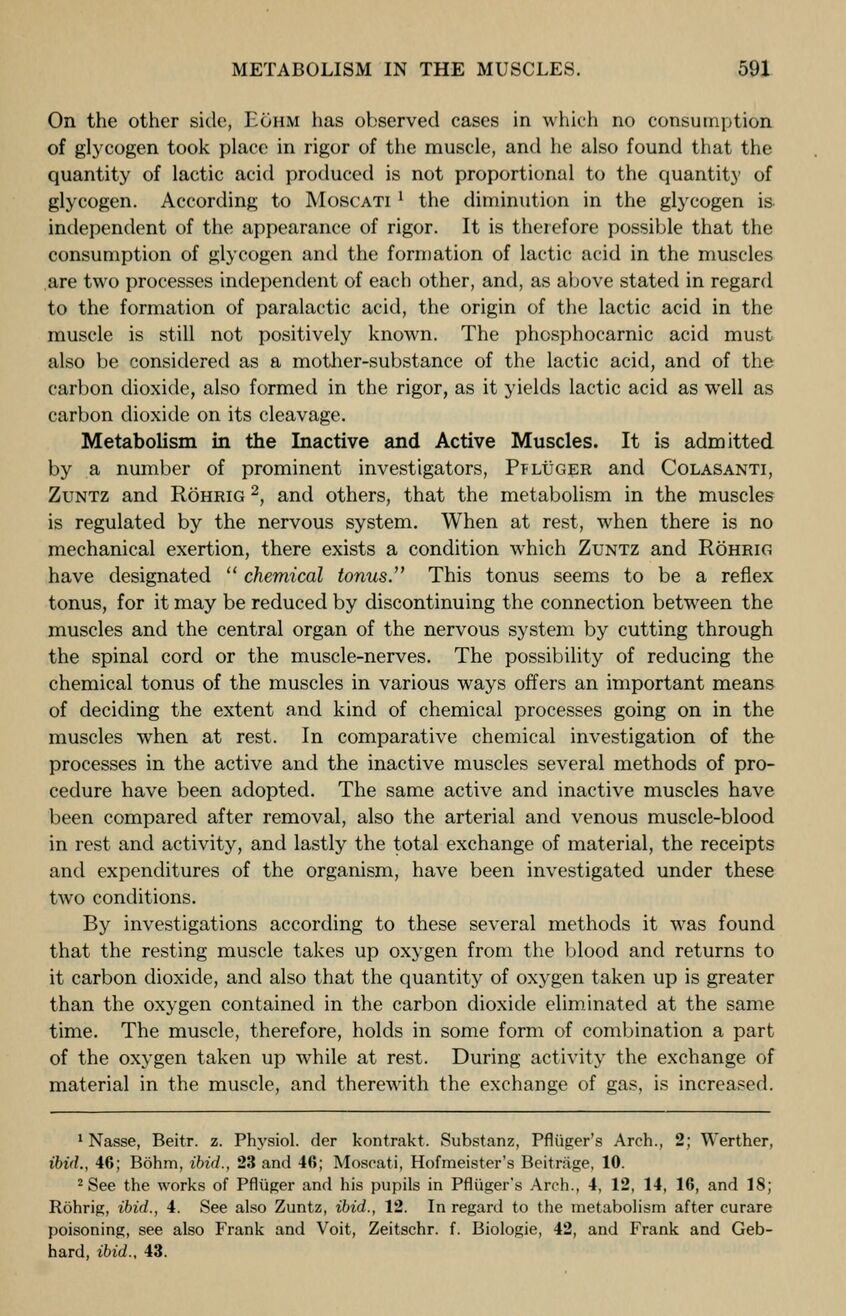
Full resolution (JPEG) - On this page / på denna sida - X. The Muscles - Extractive Bodies of the Muscles

<< prev. page << föreg. sida << >> nästa sida >> next page >>
Below is the raw OCR text
from the above scanned image.
Do you see an error? Proofread the page now!
Här nedan syns maskintolkade texten från faksimilbilden ovan.
Ser du något fel? Korrekturläs sidan nu!
This page has never been proofread. / Denna sida har aldrig korrekturlästs.
METABOLISM IN THE MUSCLES. 591
On the other side, Eohm has observed cases in which no consumption
of glycogen took place in rigor of the muscle, and he also found that the
quantity of lactic acid produced is not proportional to the quantity of
glycogen. According to Moscati l
the diminution in the glycogen is-
independent of the appearance of rigor. It is therefore possible that the
consumption of glycogen and the formation of lactic acid in the muscles
are two processes independent of each other, and, as above stated in regard
to the formation of paralactic acid, the origin of the lactic acid in the
muscle is still not positively known. The phosphocarnic acid must
also be considered as a mother-substance of the lactic acid, and of the
carbon dioxide, also formed in the rigor, as it yields lactic acid as well as
carbon dioxide on its cleavage.
Metabolism in the Inactive and Active Muscles. It is admitted
by a number of prominent investigators, Pfluger and Colasanti,
Zuntz and Rohrig 2
, and others, that the metabolism in the muscles
is regulated by the nervous system. When at rest, when there is no
mechanical exertion, there exists a condition which Zuntz and Rohrig
have designated " chemical tonus." This tonus seems to be a reflex
tonus, for it may be reduced by discontinuing the connection between the
muscles and the central organ of the nervous system by cutting through
the spinal cord or the muscle-nerves. The possibility of reducing the
chemical tonus of the muscles in various ways offers an important means
of deciding the extent and kind of chemical processes going on in the
muscles when at rest. In comparative chemical investigation of the
processes in the active and the inactive muscles several methods of pro-
cedure have been adopted. The same active and inactive muscles have
been compared after removal, also the arterial and venous muscle-blood
in rest and activity, and lastly the total exchange of material, the receipts
and expenditures of the organism, have been investigated under these
two conditions.
By investigations according to these several methods it was found
that the resting muscle takes up oxygen from the blood and returns to
it carbon dioxide, and also that the quantity of oxygen taken up is greater
than the oxygen contained in the carbon dioxide eliminated at the same
time. The muscle, therefore, holds in some form of combination a part
of the oxygen taken up while at rest. During activity the exchange of
material in the muscle, and therewith the exchange of gas, is increased.
1
Nasse, Beitr. z. Physiol, der kontrakt. Substanz, Pfluger’s Arch., 2; Werther,
ibid., 46; Bohm, ibid., 23 and 46; Moscati, Hofmeister’s Beitrage, 10.
2
See the works of Pfliiger and his pupils in Pfluger’s Arch., 4, 12, 14, 16, and 18;
Rohrig, ibid., 4. See also Zuntz, ibid., 12. In regard to the metabolism after curare
poisoning, see also Frank and Voit, Zeitschr. f. Biologie, 42, and Frank and Geb-
hard, ibid., 43.
<< prev. page << föreg. sida << >> nästa sida >> next page >>